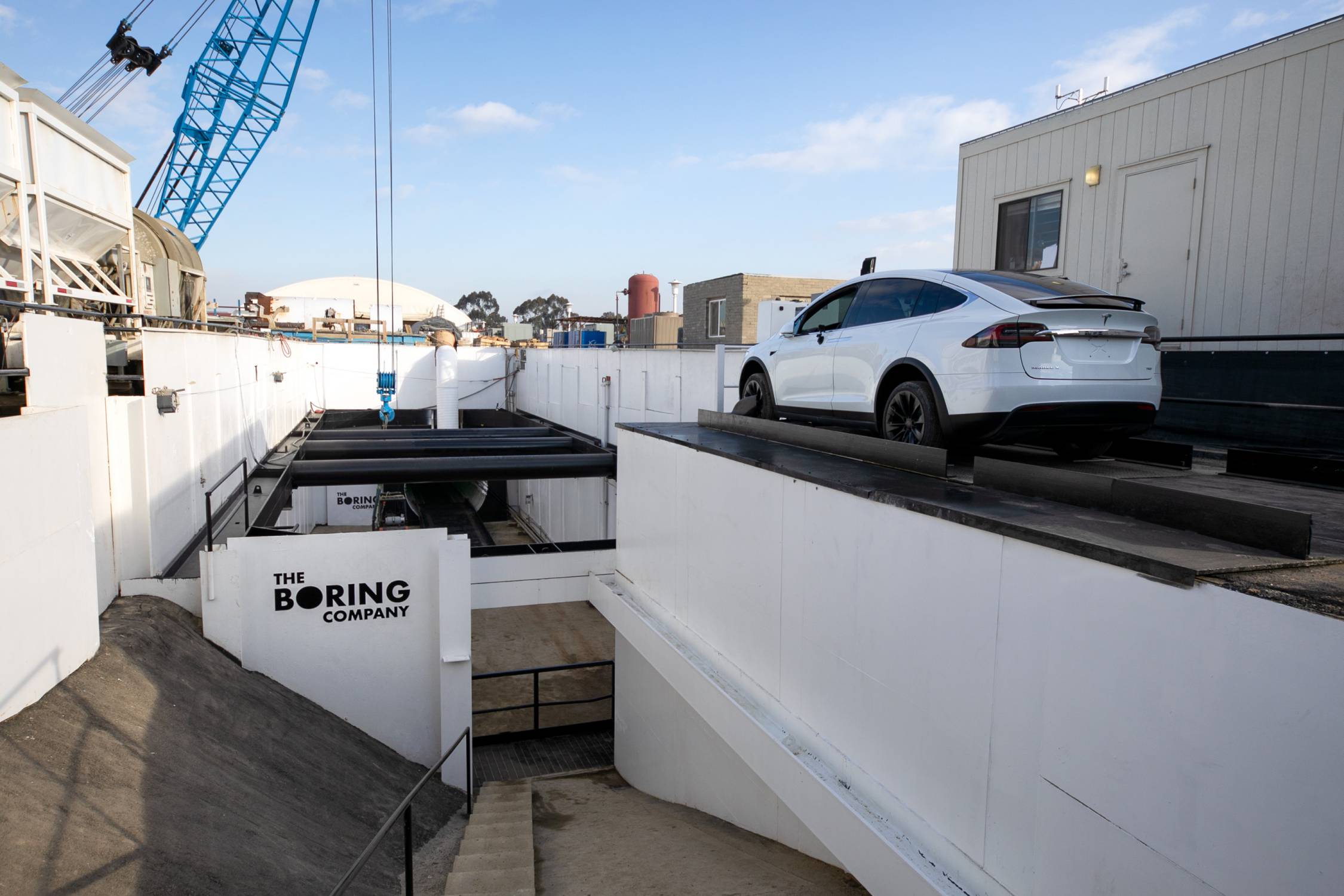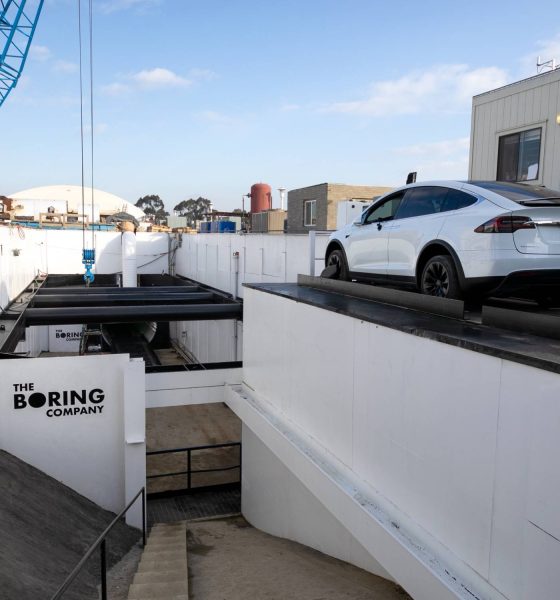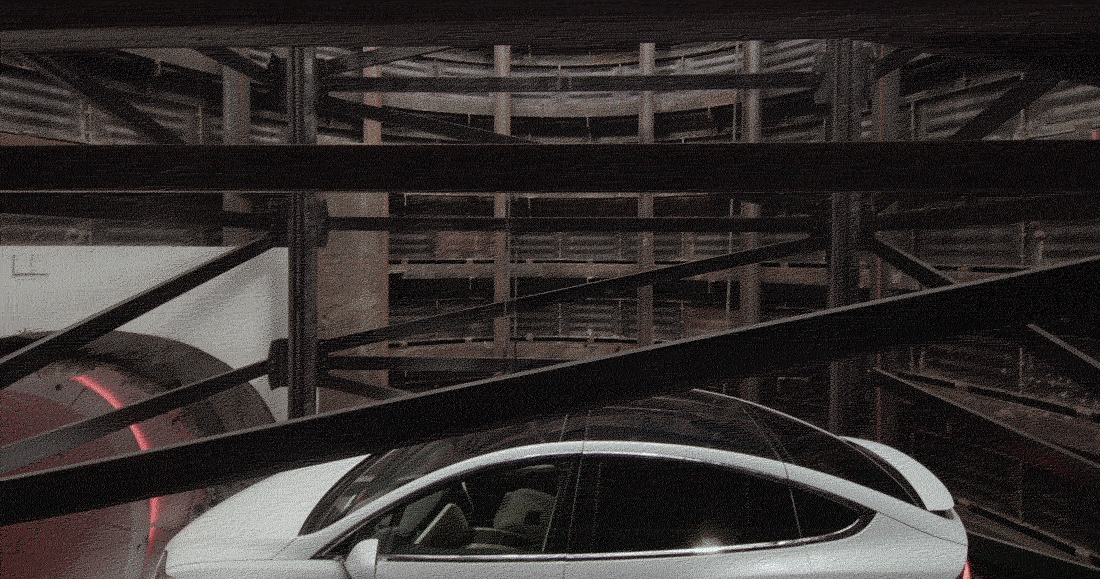

News
The Boring Company’s unveiling showed another Musk-driven disruption in the making
Before the opening party for the Hawthorne test tunnel began, Elon Musk gave a rather straightforward presentation about The Boring Company’s technology to members of the media. The discussion provided a number of pertinent updates and new information about the tunneling startup’s activities, several of which were reiterated when Musk took the stage to open the unveiling event.
As the Tesla and SpaceX CEO lightheartedly discussed the updated concepts of The Boring Company’s tunneling technology, it quickly became evident that Tuesday’s event could very well be the start of yet another Elon Musk-driven disruption.
Every single company that Elon Musk started, or played a part in starting, has gone on to be a disruptor of an established industry. In his 20s, Musk and his brother Kimbal shook up the widely established Yellow Pages industry with Zip2. Musk later took on traditional banking with X.com, which eventually merged with PayPal, one of the internet’s most established financial services that are still widely used today. Tesla, an electric car startup Musk backed in its very early days, is now an automaker forcing legacy carmakers to design and release compelling EVs. SpaceX, a company that could be considered as the culmination of Musk’s childhood dreams of interplanetary travel, is becoming more and more prevalent in the US space industry.
Man vs. Traffic pic.twitter.com/UDDE7oucKM
— TESLARATI (@Teslarati) December 19, 2018
In a way, Musk’s penchant for disruption results from his tendency to look at problems and adopt unconventional strategies to arrive at breakthrough results. In the case of SpaceX, for example, it was the company’s capability to reuse rockets that is allowing it to compete in the space industry. Electric vehicles existed before Tesla too, but the company made itself different by creating EVs that were desirable in both design and performance. This same thinking was evident when Musk presented his ideas for The Boring Company. The startup didn’t necessarily reinvent the wheel when it came to tunneling, but the company did employ a number of novel solutions that allowed it to make tunneling a lot faster, for a far lower price.
At the core of The Boring Company’s concepts are its smaller tunnel designs, which feature roughly half the diameter of conventional tunnels. This, according to the startup, reduces costs by 3-4 times. The Boring Company is also aiming to develop ways to increase the speed of its Tunnel Boring Machines (TBMs). Traditional TBMs are notable for their slow speed, and Elon Musk has lightly noted that a snail is effectively 14 times faster than a boring machine. As such, the Boring Co. aims to develop TBMs that can actually keep pace with a snail. The Hawthorne test tunnel provides a glimpse of the cost savings associated with the company’s tunnel design as well, as the 1.14-mile project was completed with just $10 million of funding. Musk notes that conventional tunneling projects, which use larger tunnels and slower machines, can balloon to up to $1 billion per mile.
A shrine to the late Gary who inspired it all. Pineapple gummies to celebrate. pic.twitter.com/ZFTbui6TcC
— TESLARATI (@Teslarati) December 19, 2018
Musk has mentioned that The Boring Company has been working on improving the capabilities of its TBMs. For its next-gen machine, Musk stated that the tunneling startup had developed a new TBM cutter head that operates faster, allowing it to process and move dirt in a more efficient manner. The Tesla and SpaceX CEO further noted that The Boring Company is developing a system that will enable reinforcement segments to be created and set up on site. The company is even planning on using the dirt from the cutter head as material for tunnel reinforcements. Such a system would allow the tunneling startup to increase its digging speeds even further, especially considering that conventional tunneling practices usually involve only 10% of actual digging, with 90% of operations usually being consumed by the laying of tunnel reinforcements.
Being a company started by Elon Musk, The Boring Company is in a constant state of innovation. This was evident in the updates to the electric skates design that were initially planned for the Loop system. Concepts of the high-speed tunnels involved vehicles traveling on electric skates. On Tuesday, though, Musk noted that “There won’t be a skate. The vehicle is the skate.” Such a system was adopted in the Hawthorne tunnel’s test rides, where a Model X fitted with electric skates on its front wheels was used to transport passengers through the tunnel. Even the garage-elevator that would be used to lift vehicles back onto the road is created with efficiency in mind, being pre-fabricated and constructed off-site.

Just like his other ventures, The Boring Company has the potential to be a disruptor. With its ultra-high-speed tunnels, the startup might actually help solve the problem of traffic congestion. The Boring Company’s tunnels could even be a stepping stone towards the eventual creation of Hyperloop transportation, which involves pods traveling inside low-pressure tubes at speeds of up to 700 mph. The Boring Company’s disruption might not only be limited to transportation, either, as the startup is also poised to release the Boring Bricks, which are blocks made from tunneling rock that could be used for low-cost housing. Permits for the creation of The Brick Store, a physical outlet where these blocks are set to be sold, have also been.
The Boring Company might be a fun startup, complete with Not-a-Flamethrowers, pet snails, sharp-tongued French knights, and a Monty Python-style watchtower made of Boring Bricks, but beneath all the unveiling event’s fun atmosphere was the sense that there is another disruption in the making — one that could complement the innovations being pushed by SpaceX and Tesla.

News
Tesla China delivery centers look packed as 2025 comes to a close
Needless to say, it appears that Tesla China seems intent on ending 2025 on a strong note.

Tesla’s delivery centers in China seem to be absolutely packed as the final days of 2025 wind down, with photos on social media showing delivery locations being filled wall-to-wall with vehicles waiting for their new owners.
Needless to say, it appears that Tesla China seems intent on ending 2025 on a strong note.
Full delivery center hints at year-end demand surge
A recent image from a Chinese delivery center posted by industry watcher @Tslachan on X revealed rows upon rows of freshly prepared Model Y and Model 3 units, some of which were adorned with red bows and teddy bears. Some customers also seem to be looking over their vehicles with Tesla delivery staff.
The images hint at a strong year-end push to clear inventory and deliver as many vehicles as possible. Interestingly enough, several Model Y L vehicles could be seen in the photos, hinting at the demand for the extended wheelbase-six seat variant of the best-selling all-electric crossover.
Strong demand in China
Consumer demand for the Model Y and Model 3 in China seems to be quite notable. This could be inferred from the estimated delivery dates for the Model 3 and Model Y, which have been extended to February 2026 for several variants. Apart from this, the Model Y and Model 3 also continue to rank well in China’s premium EV segment.
From January to November alone, the Model Y took China’s number one spot in the RMB 200,000-RMB 300,000 segment for electric vehicles, selling 359,463 units. The Model 3 sedan took third place, selling 172,392. This is quite impressive considering that both the Model Y and Model 3 are still priced at a premium compared to some of their rivals, such as the Xiaomi SU7 and YU7.
With delivery centers in December being quite busy, it does seem like Tesla China will end the year on a strong note once more.
News
Tesla Giga Berlin draws “red line” over IG Metall union’s 35-hour week demands
Factory manager André Thierig has drawn a “red line” against reducing Giga Berlin’s workweek to 35 hours, while highlighting that Tesla has actually increased its workers’ salaries more substantially than other carmakers in the country.

Tesla Giga Berlin has found itself in a new labor dispute in Germany, where union IG Metall is pushing for adoption of a collective agreement to boost wages and implement changes, such as a 35-hour workweek.
In a comment, Giga Berlin manager André Thierig drew a “red line” against reducing Giga Berlin’s workweek to 35 hours, while highlighting that Tesla has actually increased its workers’ salaries more substantially than other carmakers in the country.
Tesla factory manager’s “red line”
Tesla Germany is expected to hold a works council election in 2026, which André Thierig considers very important. As per the Giga Berlin plant manager, Giga Berlin’s plant expansion plans might be put on hold if the election favors the union. He also spoke against some of the changes that IG Metall is seeking to implement in the factory, like a 35-hour week, as noted in an rbb24 report.
“The discussion about a 35-hour week is a red line for me. We will not cross it,” Theirig said.
“(The election) will determine whether we can continue our successful path in the future in an independent, flexible, and unbureaucratic manner. Personally, I cannot imagine that the decision-makers in the USA will continue to push ahead with the factory expansion if the election results favor IG Metall.”
Giga Berlin’s wage increase
IG Metall district manager Jan Otto told the German news agency DPA that without a collective agreement, Tesla’s wages remain significantly below levels at other German car factories. He noted the company excuses this by referencing its lowest pay grade, but added: “The two lowest pay grades are not even used in car factories.”
In response, Tesla noted that it has raised the wages of Gigafactory Berlin’s workers more than their German competitors. Thierig noted that with a collective agreement, Giga Berlin’s workers would have seen a 2% wage increase this year. But thanks to Tesla not being unionized, Gigafactory Berlin workers were able to receive a 4% increase, as noted in a CarUp report.
“There was a wage increase of 2% this year in the current collective agreement. Because we are in a different economic situation than the industry as a whole, we were able to double the wages – by 4%. Since production started, this corresponds to a wage increase of more than 25% in less than four years,” Thierig stated.
News
Tesla is seeing a lot of momentum from young Koreans in their 20s-30s: report
From January to November, young buyers purchased over 21,000 Teslas, putting it far ahead of fellow imported rivals like BMW and Mercedes-Benz.

Tesla has captured the hearts of South Korea’s 20s-30s demographic, emerging as the group’s top-selling imported car brand in 2025. From January to November, young buyers purchased over 21,000 Teslas, putting it far ahead of fellow imported rivals like BMW and Mercedes-Benz.
Industry experts cited by The Economist attributed this “Tesla frenzy” to fandom culture, where buyers prioritize the brand over traditional car attributes, similar to snapping up the latest iPhone.
Model Y dominates among young buyers
Data from the Korea Imported Automobile Association showed that Tesla sold 21,757 vehicles to the 20s-30s demographic through November, compared to BMW’s 13,666 and Mercedes-Benz’s 6,983. The Model Y led the list overwhelmingly, with variants like the standard and Long Range models topping purchases for both young men and women.
Young men bought around 16,000 Teslas, mostly Model Y (over 15,000 units), followed by Model 3. Young women followed a similar pattern, favoring Model Y (3,888 units) and Model 3 (1,083 units). The Cybertruck saw minimal sales in this group.
The Model Y’s appeal lies in its family-friendly SUV design, 400-500 km range, quick acceleration, and spacious cargo, which is ideal for commuting and leisure. The Model 3, on the other hand, serves as an accessible entry point with lower pricing, which is valuable considering the country’s EV subsidies.
The Tesla boom
Experts described Tesla’s popularity as “fandom culture,” where young buyers embrace the brand despite criticisms from skeptics. Professor Lee Ho-geun called Tesla a “typical early adopter brand,” comparing purchases to iPhones.
Professor Kim Pil-soo noted that young people view Tesla more as a gadget than a car, and they are likely drawn by marketing, subsidies, and perceived value. They also tend to overlook news of numerous recalls, which are mostly over-the-air software updates, and controversies tied to the company.
Tesla’s position as Korea’s top import for 2025 seems secured. As noted by the publication, Tesla’s December sales figures have not been reported yet, but market analysts have suggested that Tesla has all but secured the top spot among the country’s imported cars this year.








